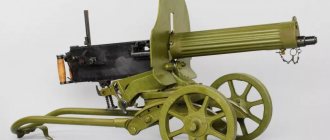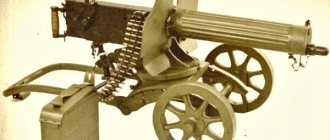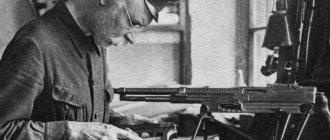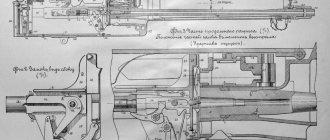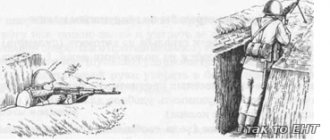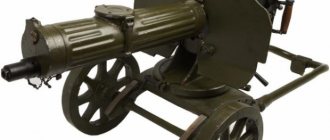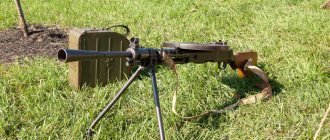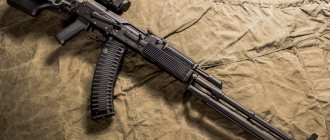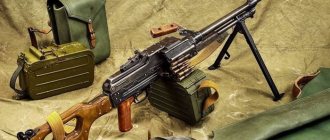The Maxim machine gun is the first automatic weapon in history that uses the removal of powder gases to fire and reload a cartridge. The developed Maxim machine gun, the design and operating principle of which turned out to be so successful that from the second half of the 19th century to the present, this heavy machine gun is still in service in the modern world. Having all kinds of modifications and calibers, the principle of shooting remains unchanged.
Machine gun Maxim SHP
History of appearance
The Gatling gun is a figment of the imagination and hands of a man who did not have a military education, but was a certified doctor. Despite the fact that instead of saving lives, its creator intended to effectively take them, it was thanks to this weapon that he left a mark on human history. Richard Jonathan Gatling (1818-1903) had a passion for invention from a young age. Having become a certified doctor, he did not devote himself to the health of patients for long, but began to develop effective weapons. In 1862, he received his first patent for the Revolving Battery Gun. At that time, the fastest-firing weapons were revolvers and repeating rifles. Their disadvantage was the long reloading time, which had to be done after several shots. Gatling decided to create a new system that would be convenient, reliable and would not require long downtime to change cartridges.
Operating principle
The first Gatling gun created a real sensation. Many could not even imagine that it was possible to solve the problem of rate of fire and reloading with such grace. The operating principle of the Gatling gun is so simple that it is surprising that the most famous gunsmiths in the world had not thought of it before. For his gun, the doctor chose a rotating cylinder as a means of feeding the next cartridge into the barrel. He brought him to the firing mechanism, which accelerated the firing of shots. The 1862 Gatling gun had 6 barrels. They were attached to a special rotor unit. 6 shutters were placed in its grooves. The Gatling gun, the design of which was elementary to the point of banality, allowed us to take a different look at the possibilities of rate of fire. When the rotor block rotated, each barrel, which had its own bolt, went through 6 stages in a circle:
- opening the shutter;
- removing the sleeve;
- sending a new cartridge;
- closing the shutter;
- Preparation;
- shot.
The Gatling machine gun, the drawings of which are available in our review, is simply amazing in its exceptional simplicity and effectiveness. That is why, even a century and a half after its invention, the military did not lose their interest in it. The Gatling machine gun can now be found in service with many armies around the world. They are installed on armored vehicles, vehicles, aircraft, ships and used manually.
First demonstration and slow progress
The first Gatling gun was demonstrated in 1862 in Indianapolis. At first it was not much better than the weapons of other inventors. The Gatling gun was able to demonstrate its real advantage only after it used bimetallic cartridges with a pointed bullet and a primer inserted during manufacture. Despite the fact that such ammunition was invented several years before the advent of the Gatling gun, they were used extremely rarely. Only in 1866 did the inventor, Colonel E. Boxer, add a centrally located primer to such a cartridge. Such ammunition received Gatling approval only five years later, when tubes made of copper wire attached to the base proved their worth in rapid-fire shooting.
Advantages and disadvantages of the Maxim machine gun
Advantages
- high rate of fire;
- good accuracy of fire;
- high reliability and durability;
- the ability to fire in long bursts;
- large ammunition load;
- presence of armor protection;
- comfortable ergonomics when shooting.
Flaws
- short effective firing range;
- how much does a Maxim machine gun weigh?
- low maneuverability;
- high profile, making camouflage difficult and making the machine gunner an easy target;
- complexity of the design, making disassembly and assembly difficult;
- high cost and difficulty in production;
- low efficiency when water is scarce;
- combat crew of 3 people.
Ammo
The Gatling gun, like other weapons of the era, used cylindrical cartridges to fire. They were rolls of wax paper into which gunpowder and a bullet were stuffed. The design of the Gatling machine gun for continuous firing provided for the presence of special steel tubes, the walls of which were particularly strong. The cartridges were inserted into them and sealed. A puncture was made in their base, which had room for the detonator. The entire package of tubes with cartridges was fed into the barrel by rotating the breech of the weapon mechanism. It acted as a disposable chamber (a cavity in a gun), removed after firing. After shooting the ammunition, the cycle was repeated.
The advantage of paper cartridges was that they burned almost completely with the charge they contained, so there was no need to remove them from the chamber. That is why Gatling persisted for so long in using new types of ammunition. Copper and brass cartridge cases had to be removed after firing. To facilitate this procedure, they were equipped with a rim located at the base. A special pulling device grabbed the cartridge case for removal from the chamber. There were several varieties of these innovations. Ultimately, the best solution to this problem was to create a bolt device that removed the spent cartridge case and loaded a new cartridge from a special magazine in just one back-and-forth motion. Gatling adapted this device for his rotating machine gun. He almost completely changed the design of the first gun and combined the barrel and chamber.
Trunks
Gatling mounted a group of 6 barrels on one axis. Moreover, they are all evenly located around. By rotating them all together, he was able to solve the alignment problem. A simple fixed cam moved the bolts in each chamber back from the firing position and forward again (on the way down, where the empty chamber was filled again). The spent cartridge was ejected at approximately the ten o'clock position. It occurred when the shooter turned the handle to rotate the barrel assembly.
The machine gun was equipped with a magazine located on top. The supply of ammunition was carried out without a spring by gravity. During one cycle of rotating the block of barrels by 360°, each of them fired a single shot, was released from the cartridge case and loaded again.
Drive and carriage
The six-barreled Gatling gun was equipped with a manual drive. The military man used a special handle to rotate the block of barrels. The rate of fire and firing range of this system was greater than that of artillery guns of that time. Since the size of the Gatling gun at that time was very large, it was mounted on carriages and was often equated to a cannon.
Tactical and technical characteristics of the Maxim machine gun
— Adopted: 1889 — Designer: Maxim, Hiram Stevens — Developed: 1883
Maxim machine gun weight
— 27.2 kg
Dimensions of the Maxim machine gun
— Length, mm: 1067 — Barrel length, mm: 721
Maxim machine gun cartridge
- 7.62x54 mm R (Maxim model 1910) - 7.92x57 mm Mauser (MG 08) - .303 British (Vickers) - 7.5x55 mm (MG 11) - 8x50 mm R Mannlicher
Maxim machine gun caliber
— 7.62 mm
Maxim machine gun rate of fire
— 600 shots/min
Maxim machine gun bullet speed
— 740 m/s
Operating principles: barrel recoil, crank locking Type of ammunition: machine gun belt for 250 rounds.
First order
Gatling received his first official order for the manufacture of a multi-barreled machine gun from McQuinney, Rindge & Company in Illinois. A batch of guns with a conical bore was ordered by General B. F. Butler. The caliber of the gun was 0.58 inches. For 12 weapons, Gatlig received a decent amount of 12 thousand US dollars. General Butler used the resulting guns during the siege of Petersburg (Virginia) in 1864. Since Gatling demanded a high price for his machine guns at that time, demand for them was quite low. Only small quantities were ordered from the creator of rapid-fire guns, which did not justify his hopes for industrial production on a large scale.
Improvement
Over the course of several years, the inventor continued to improve his creation. The Gatling gun, whose design remained largely the same, achieved a stable rate of fire. It fired 300 rounds per minute. Moreover, in many tests it was even higher. In 1866, the Gatling gun was introduced to the market in two modifications:
- A six-barreled heavy gun, the caliber of which was 1 inch. Such guns were mounted on massive carriages with large wheels. From a distance they looked like real cannons.
- Ten-barreled light gun with a caliber of 0.45 inches.
At this time, the Gatling gun received official approval from representatives of the US Army.
Combat use
The British first used a machine gun on the battlefield during the battle against the Mahdi's superior army in Sudan. An army of thousands, armed with muskets, was defeated in a short period. The results of this massacre showed that the tactics of field battles must change radically. This fact was confirmed by the events that took place on the battlefields of the 20th century.
Changes in troop tactics after the introduction of the machine gun:
- the infantry went deeper into the trenches;
- the cavalry ceased to exist;
- line attacks stopped;
- gun volleys are a thing of the past.
The first samples were equipped with heavy gun carriages and resembled a cannon. They were classified as artillery and used for the defense of fortresses and fortified positions.
Hiram Stevens with the first sample on the carriage
Classic image of a Maxim machine gun
The first large-scale use of the machine gun in the 20th century occurred between Russia and Japan in May 1904 in the defense of Port Arthur. Both sides used them as miniature artillery, opening fire from the rear, over the heads of their soldiers, at enemy positions. The same version of the Maxim weapon was used during the 1st World War.
After a number of modifications, the sample acquired the well-known classic appearance on a frame with wheels. This option was more mobile; it was used not only in defense, but also in attack. The weight of the weapon changed from 244 to 65 kg.
The machine gun was mounted on spring carts.
As well as armored cars, armored trains and ships. It was also used in anti-aircraft artillery.
During the Civil War, the cart was used effectively against infantry and cavalry. Nestor Makhno was the first to use the tactics of fighting on carts.
Maxim on a cart
With the advent of armored vehicles and tanks in the army, carts lost their role, and the legendary machine gun continued its life.
Armored car with a Maximov machine gun
Russian invention - motorized machine gun
The machine gun was widely used during the Civil and Great Patriotic Wars. The last large-scale use of these weapons was during the Sino-Soviet conflict on Damansky Island in 1969.
Currently, the machine gun is used by units of the Ukrainian Armed Forces in the civil conflict in the South-East of Ukraine.
A Right Sector fighter and a Maximka machine gun at a firing position near Donetsk
Further promotion
In the late 60s of the 19th century, Gatling sold several large quantities of guns not only to his military, but also to the armies of Great Britain, Russia, Turkey, Japan, and Spain. Gatling guns were constantly being improved. The inventor constantly improved their reliability and rate of fire. In 1876, a mechanical 5-barrel 0.45-inch model fired 700 rounds per minute. The rate of fire of the Gatling machine gun when firing in short bursts reached 1000 rounds per minute. Despite this rhythm of work, the gun barrels did not overheat at all, since each of them fired no more than 200 shots. At the same time, they were also cooled with the help of the air flow created during rotation. The Gatling machine gun in traditional versions has 4-10 barrels with a caliber of 12-40 mm. Firing range – up to 1 km.
At the end of the 19th and beginning of the 20th centuries, electric drives began to be installed on Gatling guns. This modernization brought the machine gun’s rate of fire to a record 3,000 rounds per minute. There was one significant drawback in such a system: the electric drive made the weapon even more cumbersome. Subsequently, the armies of the world began to give preference to single-barreled machine guns, which were more compact and maneuverable. Gatling's brainchild began to be gradually forgotten.
Maxim machine gun - video
The outdated but very reliable Maxim machine gun is found in hot spots around the world even today.
In 1873, American inventor Hiram Stevens Maxim created the first example of an automatic weapon - the Maxim machine gun. He decided to use the recoil energy of the weapon, which had not been used in any way before. But testing and practical use of these weapons were stopped for 10 years, since Maxim was not only a gunsmith and, in addition to weapons, was interested in other inventions. His range of interests included various technology, electricity, and so on, and the machine gun was just one of his many inventions. In the early 1880s, Maxim finally took up his machine gun, but in appearance his weapon was already very different from the 1873 model. Perhaps these ten years were spent thinking about, calculating and improving the design in the drawings. After this, Hiram Maxim made a proposal to the US government to accept his machine gun for service. But no one in the USA was interested in the invention, and then Maxim emigrated to Great Britain, where its development initially also did not arouse much interest from the military. However, the British banker Nathaniel Rothschild, who was present at the testing of the new weapon, became seriously interested in it and agreed to finance the development and production of the machine gun.
The Maxima Arms Company began to manufacture and advertise machine guns, showing their work in many countries. Hiram Maxim managed to achieve excellent survivability and reliability of his weapon, and at the end of 1899, his machine gun, chambered for the British .303 caliber (7.7 mm) cartridge, fired 15 thousand rounds without any serious difficulties.
System
The Maxim system machine gun (or simply “Maxim”) is an automatic weapon based on automatic recoil with a short-stroke barrel. As the shot is fired, the powder gases send the barrel back, setting in motion the reloading mechanism, which removes the cartridge from the fabric tape, sends it into the breech and at the same time cocks the bolt. After firing the shot, the operation is repeated again. The machine gun has an average rate of fire of 600 rounds per minute (depending on versions, varies from 450 to 1000), and the combat rate of fire is 250-300 rounds per minute.
To fire a 1910 model machine gun, 7.62x54 mm R rifle cartridges with 1908 model (light bullet) and 1930 model (heavy bullet) bullets are used. The trigger system is designed only for automatic fire and has a safety lock against accidental shots. The machine gun is powered by cartridges from a slider-type receiver, with a fabric or metal belt with a capacity of 250 cartridges, which appeared later. The sighting device includes a rack-mount sight and a front sight with a rectangular top. Some machine guns could also be equipped with an optical sight. The machine gun was initially mounted on bulky carriages, modeled after mitrailleuse carriages; then portable machines appeared, usually on tripods; Since 1910, the Russian army has used a wheeled machine developed by Colonel A. A. Sokolov. This machine gave the machine gun sufficient stability when firing and, unlike tripods, made it possible to easily move the machine gun when changing position.
Main details
— Box — Casing — Butt plate — Shutter — Receiver — Return spring — Return spring box — Lock — Trigger lever
The production of one Maxim machine gun required 2448 operations and took 700 working hours.
Hiram Maxim with his machine gun
Maxim machine gun in Russia
After a successful demonstration of the machine gun in Switzerland, Italy and Austria, Hiram Maxim came to Russia with a demonstrative example of a .45-caliber (11.43 mm) machine gun. In 1887, the Maxim machine gun chambered for the 10.67 mm Berdan rifle cartridge with black powder was tested. On March 8, 1888, Emperor Alexander III fired from it. After the tests, representatives of the Russian military department ordered Maxim 12 machine guns of the 1885 model chambered for the 10.67 mm Berdan rifle cartridge.
The company “Sons of Vickers and Maxim” began supplying Maxim machine guns to Russia. The machine guns were delivered to St. Petersburg in May 1889. The Russian navy also became interested in the new weapon and ordered two more machine guns for testing. Subsequently, the Berdan rifle was removed from service, and the Maxim machine guns were converted to accept the 7.62 mm cartridge of the Russian Mosin rifle. In 1891-1892 Five machine guns chambered for 7.62x54 mm cartridges were purchased for testing. During 1897-1904. Another 291 machine guns were purchased.
In 1901, the 7.62-mm Maxim machine gun on an English-style wheeled carriage was adopted by the ground forces; during this year, the first 40 Maxim machine guns entered the Russian army. The machine gun (the mass of which on a heavy carriage with large wheels and a large armored shield was 244 kg) was assigned to the artillery. The machine guns were planned to be used for the defense of fortresses, to repel massive attacks by enemy infantry with fire from pre-equipped and protected positions. In March 1904, a contract was signed for the production of Maxim machine guns at the Tula Arms Plant. The cost of production of the Tula machine gun (942 rubles + 80 pounds sterling commission, about 1,700 rubles in total) was cheaper than the cost of acquisition from the British (2,288 rubles 20 kopecks per machine gun). In May 1904, serial production of machine guns began at the Tula Arms Plant.
Machine gun "Maxim" model 1895 on a fortress carriage with a shield.
Application
The Maxim machine gun was intended to support infantry with fire, as well as to suppress enemy fire and clear the way for infantrymen during an attack, or for cover during a retreat. In defense, the Maxim machine gun was intended to combat enemy firing points and to fire at open approaches. At the end of the 19th and beginning of the 20th centuries, European pacifists often demanded a complete ban on the use of machine guns in military conflicts, as an inhumane weapon. These demands were provoked by the fact that Great Britain was the first among the colonial empires to identify the advantages of the machine gun and actively began to use it in clashes with poorly armed native rebels.
In Sudan on September 2, 1898, at the Battle of Omdurman, a 10,000-strong Anglo-Egyptian army fought a 100,000-strong Sudanese army, which consisted mainly of irregular cavalry. The attacks of the Sudanese cavalry were repulsed by massive machine-gun fire. The British units suffered minor losses.
Combat use in the Russo-Japanese War
The Maxim machine gun was used during the Russo-Japanese War. In one of the battles near Mukden, a Russian battery, equipped with sixteen Maxim machine guns (at that time in the Russian army machine guns were subordinate to the artillery department), resisted several Japanese attacks, and soon the Japanese side lost half of the attackers. Without the help of machine guns it would have been impossible to repel these attacks so effectively. Having fired several tens of thousands of rounds in a relatively short period of time, the Russian machine guns nevertheless did not fail and were in good condition, thereby proving their exceptional combat characteristics. Now machine guns began to be purchased in the hundreds, despite the significant price, over 3,000 rubles per machine gun. At the same time, they were already removed from the heavy carriages by the troops and, in order to increase maneuverability, they were placed on homemade machines that were lighter and more convenient to transport.
An ensign of the Military Driving School at a machine gun in the back of a Berliet training armored vehicle. Petrograd. 1915
Application in the Great Patriotic War
The Maxim machine gun was actively used by the Red Army in the Great Patriotic War. It was used by both infantry and mountain rifle units, as well as the navy. During the war, not only designers and manufacturers tried to increase the combat capabilities of the Maxim, but also directly among the troops. Soldiers often removed the armor shield from the machine gun, thereby trying to increase maneuverability and achieve less visibility. For camouflage, in addition to camouflage coloring, covers were put on the casing and shield of the machine gun. In winter, the Maxim was mounted on skis, sleds or a drag boat, from which they fired. During the Great Patriotic War, machine guns were mounted on light SUVs “Willis” and GAZ-64.
There was also a quadruple anti-aircraft version of the Maxim. This ZPU was widely used as a stationary, self-propelled, ship-based one, and was installed in the bodies of cars, armored trains, railway platforms, and on the roofs of buildings. Maxim machine gun systems have become the most common military air defense weapon. The quadruple anti-aircraft machine gun mount of the 1931 model differed from the usual "Maxim" in the presence of a forced water circulation device and a large capacity of machine gun belts - 1000 rounds instead of the usual 250. Using anti-aircraft ring sights, the mount was able to conduct effective fire on low-flying enemy aircraft (maximum at altitudes up to 1400 m at speeds up to 500 km/h). These mounts were also often used to support infantry.
By the end of the 1930s, the Maxim design was obsolete. The body of the machine gun (without the machine, water in the casing and cartridges) had a mass of about 20 kg. The weight of Sokolov’s machine is 40 kg, plus 5 kg of water. Since it was impossible to use a machine gun without a machine and water, the working weight of the entire system (without cartridges) was about 65 kg. Moving such weight across the battlefield under fire was not easy. The high profile made camouflage difficult; Damage to the thin-walled casing in battle by a bullet or shrapnel practically rendered the machine gun inoperable. It was difficult to use Maxim in the mountains, where fighters had to use homemade tripods instead of standard machines. Supplying the machine gun with water caused significant difficulties in the summer. In addition, the Maxim system was very difficult to maintain. The cloth tape caused a lot of trouble - it was difficult to equip, it wore out, broke, and absorbed water. For comparison, a single Wehrmacht machine gun MG-34 had a mass of 10.5 kg without cartridges, was powered by a metal belt and did not require water for cooling (while being somewhat inferior to the Maxim in firepower, being in this indicator closer to the Degtyarev light machine gun, although and with one important nuance - the MG34 had a quick-change barrel, which made it possible, if there were spare barrels, to fire more intensive bursts from it). Firing from the MG-34 could be carried out without a machine gun, which contributed to the secrecy of the machine gunner’s position.
On the other hand, the positive properties of the Maxim were also noted: thanks to the shockless operation of the automatic system, it was very stable when fired from a standard machine gun, gave even better accuracy than later developments, and allowed very precise fire control. Provided proper maintenance, the machine gun could last twice as long as the established service life, which was already longer than that of new, lighter machine guns.
Machine gun team. Caucasian Front 1914-1915.
Even before the war, a significantly more advanced and modern design of an easel machine gun was developed and put into production - the DS designed by V. Degtyarev. However, due to problems with reliability and significantly greater demands on maintenance, its production was soon curtailed, and most of the copies available to the troops were lost at the initial stage of hostilities (in many ways a similar fate befell another model of the Red Army weapons - the Tokarev self-loading rifle, which was not managed to bring it to the proper level of reliability before the start of the war, and subsequently production was forced to curtail in favor of the outdated, but well-developed and familiar to the fighters of the “three-line system”).
However, the urgent need to replace the Maxim with more modern weapons did not disappear, so in 1943 the heavy machine gun of the Pyotr Goryunov SG-43 system with an air barrel cooling system was adopted. The SG-43 was superior to the Maxim in many respects. He began enlisting in the troops in the second half of 1943. Meanwhile, the Maxim continued to be produced until the end of the war at the Tula and Izhevsk factories, and until the end of production it remained the main heavy machine gun of the Red Army.
The last use of a machine gun by the Soviet army occurred in 1969 during the border conflict on Damansky Island.
However, this machine gun was and is actively used in many hot spots to this day: in particular, it is used by both opposing sides during the war in Donbass, mainly as stationary firing points.
Austin type machine gun 1 series of the 15th machine gun platoon of the Southwestern Front.
Maxim machine gun model 1910
The 7.62-mm Maxim machine gun of the 1910 model is a Russian version of the British Maxim machine gun, which was modernized at the Tula Arms Plant under the guidance of masters I. A. Pastukhov, I. A. Sudakov and P. P. Tretyakov. The body weight of the machine gun was reduced and some details were changed: the adoption of a cartridge with a pointed bullet of the 1908 model made it necessary to change the sighting devices in the Maxim machine gun, remake the receiver to fit the new cartridge, and also widen the hole in the muzzle sleeve, in order to avoid too much shaking of the machine gun when firing. The English wheeled carriage was replaced with a lightweight wheeled carriage by A. A. Sokolov, and the English-style armor shield was replaced with an armored shield of reduced dimensions. In addition, A. Sokolov designed cartridge boxes, a gig for transporting cartridges, and sealed cylinders for boxes with cartridges.
Maxim machine gun mod. 1910 with the machine weighed 62.66 kg (and together with the liquid poured into the casing to cool the barrel - about 70 kg).
Maxim machine guns mod. 1910 were used during the First World War and the Civil War, they were used as heavy machine guns, installed on armored cars, armored trains and “carts”.
German fire support horse
Maxim machine gun model 1910/30
During the combat use of the Maxim machine gun, it became clear that in most cases fire was fired at a distance from 800 to 1000 m, and at such a range there was no noticeable difference in the trajectory of the light bullet of the 1908 model and the heavy bullet of the 1930 model.
In 1930, the machine gun was again modernized, the following changes were made to the design:
- a folding butt plate was installed, as a result of which the right and left gates and the connection of the trigger lever and rod were changed - the safety was moved to the trigger, which eliminated the need to act with both hands when opening fire - a return spring tension indicator was installed - the sight was changed, a stand was introduced and clamp with a latch, the scale on the rear sight for lateral adjustments has been increased - a buffer has appeared - a holder for the shield attached to the machine gun casing - a separate firing pin has been introduced to the striker - for shooting at long distances and from closed positions, a heavy bullet of the 1930 model has been introduced, an optical sight and a protractor - quadrant - for greater strength, the barrel casing is made with longitudinal corrugation.
The modernized machine gun was named “7.62 heavy machine gun of the Maxim system, model 1910/30”
In 1940, following the experience of the Soviet-Finnish War, the machine gun received a wide filler hole and a drain valve for the pouring hole (following the example of the Finnish M32), now in winter conditions the casing could be filled with ice and snow.
Motorized machine gun - Russian invention
M/32-33
This Finnish machine gun is a variant of the Russian machine gun of the 1910 model. The Maxim M/32-33 was developed by Finnish gunsmith Aimo Lahti in 1932, it could fire at a rate of fire of 800 rounds per minute, while the Russian machine gun of the 1910 model fired at a rate of 600 rounds per minute; in addition to this, the Maxim M/32-33 had a number of other innovations. It was actively used by the Finnish side in the Soviet-Finnish War. The cartridge used differed in tolerances from the Soviet one.
Machine gunners of His Majesty's 84th Life Infantry Regiment of Shirvan.
Vickers
The Vickers is an English version of the machine gun; it was practically the main heavy automatic infantry weapon in the British Army from the time it was adopted in 1912 until the early 1960s. In addition to Great Britain, Vickers were also produced in the USA, Australia, and Portugal. Before the United States entered World War I, the War Department assessed the weapons of the Entente and subsequently ordered 4,000 Vickers machine guns from the armory at the end of 1916.
The design of the Vickers machine gun differed slightly from the design of the Russian Maxim machine gun of the 1910 model as follows:
— The castle was rotated 180 degrees so that the lower slope was facing upward; this made it possible to reduce the height and weight of the box. — The box lid is divided into two halves: the front half of the cover covers the receiver, and the back half closes the box; both parts are fixed on the same axis. — The butt plate is folding, attached to the box with two bolts (upper and lower).
Vickers in aviation
In 1914, Vickers began to be installed on military aircraft, and in 1916, the Vickers Mk I (51) appeared; its distinctive feature was air-cooled barrel and synchronizer rod for firing through the aircraft propeller. Ventilation holes were made in the barrel casing at the front and rear. The mass of the machine gun’s “body” is 13.5 kg, the number 511 indicated an increased rate of fire with the help of a buffer, which accelerated the initial roll-up speed of the mobile system. The Vickers was used by both French and Russian aircraft. The first tanks were also equipped with Vickers machine guns.
MG 08
MG 08 (German: Maschinengewehr 08) - a German version of the Maxim machine gun, it could be mounted on either a sled or a tripod machine. MG 08 was actively used by the German army in the First World War. Like the base model, the MG 08 automatic operates using a barrel recoil system. The Wehrmacht began World War II armed with, in addition to other types of machine guns, 42,722 heavy machine guns MG 08/15 and MG 08/18. By the beginning of World War II, the MG 08 was already an obsolete weapon; its use in the Wehrmacht was explained only by the lack of newer and more modern machine guns.
MG 11
The Swiss version of the Maxim machine gun was based on the German MG 08. It used the standard Swiss rifle cartridge 7.5x55 mm Schmidt-Rubin.
PV-1
PV-1 (Vozdushny Machine Gun) is a variant intended for installation on military aircraft. It differs from the base model in the way it is attached to the carrier and in the absence of a water cooling casing.
Type 24
Type 24 is a Chinese version, which is a copy of the German MG 08 (the 24th year according to the Minguo chronology corresponds to 1935 of the Gregorian calendar). Produced by the Jingling Arsenal (Nanjing) with a Dreifuß 16 tripod machine. A total of about 36 thousand pieces were produced. Subsequently, many of them were converted to the Soviet 7.62x54 mm R cartridge. There was also a modification of the air-cooled machine gun, the Type 36.
Large-caliber options
In addition to variants for rifle caliber, large-caliber versions were also produced: Vickers .50 (12.7x81 mm), used in the British Navy and Ground Forces, and the experimental MG 18 TuF (13.25x92 mm SR). The Vickers .50 was used during World War II. There were also quad variants as anti-aircraft machine guns.
Captured Russian Maxim heavy machine guns on a machine-gun gig, Berlin
Modern life
After years of undeserved oblivion, the Gatling gun has become popular again. It was especially relevant during the Second World War. It was installed on warships, vehicles, and aircraft. After the war, a large number of different modifications of this machine gun were developed. Moreover, they were all of different calibers and sizes, but the design of the Gatling machine gun remained the same. Various drives are installed on such weapons: hydraulic, electric, gas, pneumatic. The machine gun is loaded using drum magazines or cartridge belts. Modern technologies and materials have made it possible to create a very convenient and highly effective Gatling light machine gun, which is often used in special military operations by special forces.
Maxim machine gun cartridge caliber 7.62 mm. Device. Weight
The Maxim machine gun is a heavy machine gun developed by American-born British gunsmith Hiram Stevens Maxim in 1883. The Maxim machine gun became one of the founders of automatic weapons; it was widely used during the Boer War of 1899-1902, World War I and World War II, as well as in many minor wars and armed conflicts of the 20th century.
Interesting Facts
Gatling's invention lives on beyond the military. You can meet him in the most unexpected places. Thus, Space Engineers - a Gatling gun - is one of the weapons often used in a computer game about space adventures.
Since the drawings of this weapon are freely available, and you can find anything you want in stores, many craftsmen, seduced by the simplicity of the weapon’s design, decide to make it themselves. And this applies not only to models made of paper or wood, but also to fully combat-ready metal specimens. The Gatling gun was made by hand not only from iron, but even from copper. Moreover, all these attempts were quite successful. So, one craftsman created a homemade six-barreled Gatling machine gun, which was quite functional. But this does not mean that it is worth experimenting with such a serious weapon. Besides, it's illegal. It is better to stick to simple wooden or paper layouts.
Maxim machine gun: design and principle of operation
Design
General design of the Maxim machine gun
Atlas of drawings 1906
General view drawing
General view in section
Cross section and drawings of the internal mechanism
Drawing of the spring, lock fork, connecting rod and handle
Drawings of lifting mechanism parts
Images and drawings of the supporting structure
From the drawings presented above, we can conclude that the machine gun mechanisms are highly complex.
